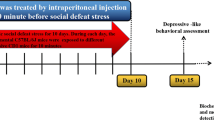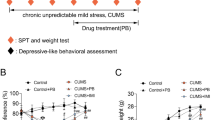Abstract
Kaempferol (KFL), the major constituent of various fruits and vegetables, could attenuate oxidaitve stress and inflammation. The aims of the present study were to explore the ameliorative abilities of KFL on the depressive-like behaviors in a chronic social defeat stress (CSDS) mouse model, and to determine the potential mechanisms on oxidative stress, neuroinflammation, and AKT/β-catenin signaling pathway. Three behavioral tests, sucrose preference test (SPT), social interaction test (SIT), and tail suspension test (TST), were used to evaluate the antidepressive effects of KFL in CSDS mice. Activity levels of antioxidant enzyme, superoxide dismutase (SOD), glutathione peroxidase (GPx), catalase (CAT), glutathione s-transferase (GST), and concentrations of malonaldehyde (MDA) and protein carbonylation in the prefrontal cortex were assessed by commercial kits, respectively. Elisa was used to detect the levels of interleukin-1β (IL-1β) and tumor necrosis factor α (TNF-α). Q-PCR was used to determine the mRNA level of CD-11b. Furthermore, activity level of AKT/β-catenin signaling in the prefrontal cortex of CSDS mice was investigated by western blot. In addition, LY294002, a PI3-K inhibitor, was used to investigate the role of AKT/β-catenin signaling in the antidepressant effects of KFL. Social defeat stress reduced the bodyweights, sucrose consumptions, social interaction times, and the tail suspension mobility times in mice. CSDS mice were also exhibited remarkablely increased levels in oxidative stress markers, inflammatory mediators, and decreased activity of AKT/β-catenin cascade in the prefrontal cortex, which were reversed by treatment with KFL. Interestingly, LY294002 appeared to partly inhibit the overall KFL-mediated protective effects in the CSDS mice. These results confirmed that KFL exerted antidepressive effects, which might be mediated, at least in part, by enhanced antioxidant abilities and anti-inflammation effects via up-regulation AKT/β-catenin cascade activity in the prefrontal cortex of CSDS mice. Thus, KFL might be a promising, effective, and safe food medicine for depression treatment.








Similar content being viewed by others
Abbreviations
- KFL:
-
Kaempferol
- SIT:
-
Social interaction test
- SPT:
-
Sucrose preference test
- TST:
-
Tail suspension test
- CAT:
-
Catalase
- SOD:
-
Superoxide dismutase
- GPx:
-
Glutathione peroxidase
- GST:
-
Glutathione S-transferase
- MDA:
-
Malonaldehyde
- IL-1β:
-
Interleukin-1β
- TNF-α:
-
Tumor necrosis factor α
- Iba-1:
-
ionized calcium binding adaptor molecule-1
References
Azar R, Mercer D (2013) Mild depressive symptoms are associated with elevated C-reactive protein and proinflammatory cytokine levels during early to midgestation: a prospective pilot study. J Womens Health 22(4):385
Chan JY, Chan SH (2015) Activation of endogenous antioxidants as a common therapeutic strategy against cancer, neurodegeneration and cardiovascular diseases: a lesson learnt from DJ-1. Pharmacol Ther 156:69–74
Chen YC et al (2012) The effect of citalopram on chronic stress-induced depressive-like behavior in rats through GSK3β/β-catenin activation in the medial prefrontal cortex. Brain Res Bull 88(4):338–344
Chen X et al (2015) The administration of erythropoietin attenuates kidney injury induced by ischemia/reperfusion with increased activation of Wnt/β-catenin signaling. J Formos Med Assoc 114(5):430–437
Covey TM et al (2010) Alkylation of the tumor suppressor PTEN activates Akt and β-catenin signaling: a mechanism linking inflammation and oxidative stress with cancer. Plos One 5(10):e13545
Deng Z-F, Zheng H-L, Chen J-G, Luo Y, Xu J-F, Zhao G, Lu J-J, Li H-H, Gao S-Q, Zhang D-Z, Zhu L-Q, Zhang Y-H, Wang F (2018) miR-214-3p targets Î2-catenin to regulate depressive-like behaviors induced by chronic social defeat stress in mice. Cereb Cortex 1–11. https://doi.org/10.1093/cercor/bhy047
Fan Ni, Luo Y, Ou Y, He H (2017) Altered serum levels of TNF-α, IL-6, and IL-18 in depressive disorder patients. Hum Psychopharmacol Clin Exp e2588. https://doi.org/10.1002/hup.2588
Gao W, Xiao C, Hu J, Chen B, Wang C, Cui B, Deng P, Yang J, Deng Z (2018) Qing brick tea (QBT) aqueous extract protects monosodium glutamate-induced obese mice against metabolic syndrome and involves up-regulation transcription factor nuclear factor-erythroid 2-related factor 2 (Nrf2) antioxidant pathway. Biomed Pharmacother 103:637–644
Gaynes BN et al (2009) What did STAR*D teach us? Results from a large-scale, practical, clinical trial for patients with depression. Psychiatr Serv 60(11):1439
Hui J, Zhang J, Kim H, Tong C, Ying Q, Li Z, Mao X, Shi G, Yan J, Zhang Z, Xi G (2015) Fluoxetine regulates neurogenesis in vitro through modulation of GSK-3β/β-catenin signaling. Int J Neuropsychopharmacol 1–12. https://doi.org/10.1093/ijnp/pyu099
Jiang B et al (2017) Antidepressant-like effects of fenofibrate in mice via the hippocampal brain-derived neurotrophic factor signalling pathway. Br J Pharmacol 17(42):177–194
Jian-yong, et al (2016) Salvianolate reduces murine myocardial ischemia and reperfusion injury via ERK1/2 signaling pathways in vivo. Chin J Integr Med 23(1):1–8
Kaidi A, Williams AC, Paraskeva C (2007) Interaction between beta-catenin and HIF-1 promotes cellular adaptation to hypoxia. Nat Cell Biol 9(2):210–217
Karege F et al (2011) Alterations in phosphatidylinositol 3-kinase activity and PTEN phosphatase in the prefrontal cortex of depressed suicide victims. Neuropsychobiology 63(4):224–231
Kim HK, Park HR, Lee JS, Chung TS, Chung HY, Chung J (2007) Down-regulation of iNOS and TNF-alpha expression by kaempferol via NF-kappaB inactivation in aged rat gingival tissues. Biogerontology 8(4):399–408
Kim SK, Kim HJ, Choi SE, Park KH, Choi HK, Lee MW (2008) Anti-oxidative and inhibitory activities on nitric oxide (NO) and prostaglandin E2 (COX-2) production of flavonoids from seeds of Prunus tomentosa Thunberg. Arch Pharm Res 31(4):424–428
Lagoa R et al (2010) Kaempferol protects against rat striatal degeneration induced by 3-nitropropionic acid. J Neurochem 111(2):473–487
Li Z et al (2017) Valproate attenuates endoplasmic reticulum stress-induced apoptosis in SH-SY5Y cells via the AKT/GSK3β signaling pathway. Int J Mol Sci 18(2):315
Lopez-Sanchez C et al (2007) Blood micromolar concentrations of kaempferol afford protection against ischemia/reperfusion-induced damage in rat brain. Brain Res 1182:123–137
Lopresti AL, Hood SD, Drummond PD (2012) Multiple antidepressant potential modes of action of curcumin: a review of its anti-inflammatory, monoaminergic, antioxidant, immune-modulating and neuroprotective effects. J Psychopharmacol 26(12):1512–1524
Ludka FK, Constantino LC, Dal-Cim T, Binder LB, Zomkowski A, Rodrigues ALS, Tasca CI (2016) Involvement of PI3K/Akt/GSK-3β and mTOR in the antidepressant-like effect of atorvastatin in mice. J Psychiatr Res 82:50–57
Maes M et al (2011a) A review on the oxidative and nitrosative stress (O&NS) pathways in major depression and their possible contribution to the (neuro)degenerative processes in that illness. Prog Neuropsychopharmacol Biol Psychiatry 35(3):676–692
Maes M et al (2011b) IgM-mediated autoimmune responses directed against multiple neoepitopes in depression: new pathways that underpin the inflammatory and neuroprogressive pathophysiology. J Affect Disord 135(1-3):414–418
Matsuda S et al (2016) Effective PI3K modulators for improved therapy against malignant tumors and for neuroprotection of brain damage after tumor therapy (review). Int J Oncol 49(5):1785–1790
Moriguchi S et al (2013) Stimulation of the Sigma-1 receptor by DHEA enhances synaptic efficacy and neurogenesis in the hippocampal dentate gyrus of olfactory bulbectomized mice. Plos One 8(4):e60863
Ng F et al (2009) Oxidative stress in psychiatric disorders: evidence base and therapeutic implications. Cheminform 40(22):851–876
Noworyta-Sokołowska K, Górska A, Gołembiowska K (2013) LPS-induced oxidative stress and inflammatory reaction in the rat striatum. Pharmacol Rep 65(4):863–869
O’Donnell P, Do KQ, Arango C (2014) Oxidative/Nitrosative stress in psychiatric disorders: are we there yet?[J]. Schizophr Bull 40(5):960–962
Pandya CD, Howell KR, Anilkumar P (2013) Antioxidants as potential therapeutics for neuropsychiatric disorders. Prog Neuropsychopharmacol Biol Psychiatry 464:214–223
Rawdin BJ et al (2013) Dysregulated relationship of inflammation and oxidative stress in major depression. Brain Behav Immuny 31(7):143–152
Sahin E, Gümüşlü S (2016) Alterations in brain antioxidant status, protein oxidation and lipid peroxidation in response to different stress models. Behav Brain Res 87(3):421–425
Shin S et al (2006) Involvement of glycogen synthase kinase-3beta in hydrogen peroxide-induced suppression of Tcf/Lef-dependent transcriptional activity. Cell Signal 18(5):601–607
Steru L et al (1985) The tail suspension test: a new method for screening antidepressants in mice. Psychopharmacology 85(3):367
Suchal K et al (2016) Kampeferol protects against oxidative stress and apoptotic damage in experimental model of isoproterenol-induced cardiac toxicity in rats. Phytomedicine 23(12):1401–1408
Sukoff Rizzo SJ et al (2012) Evidence for sustained elevation of IL-6 in the CNS as a key contributor of depressive-like phenotypes. Transl Psychiatry 2(12):e199
Taiwe GS et al (2016) Anticonvulsant activity of an active fraction extracted from Crinum jagus L. (Amaryllidaceae), and its possible effects on fully kindled seizures, depression-like behaviour and oxidative stress in experimental rodent models. J Ethnopharmacol 194:421–433
Walker ER, Mcgee RE, Druss BG (2015) Mortality in mental disorders and global disease burden implications: a systematic review and meta-analysis. Jama Psychiat 72(4):334
Whiteford HA et al (2013) Global burden of disease attributable to mental and substance use disorders: findings from the global burden of disease study 2010. Lancet 382(9904):1575–1586
Xu Y, Wang C, Klabnik JJ, O’Donnell JM (2014) Novel therapeutic targets in depression and anxiety: antioxidants as a candidate treatment. Curr Neuropharmacol 12(2):108–119
Yamawaki Y, Yoshioka N, Nozaki K, Ito H, Oda K, Harada K, Shirawachi S, Asano S, Aizawa H, Yamawaki S, Kanematsu T, Akagi H (2018) Sodium butyrate abolishes lipopolysaccharide-induced depression-like behaviors and hippocampal microglial activation in mice. Brain Res 1680:13–38
Yu L, Chen C, Wang LF, Kuang X, Liu K, Zhang H, du JR (2013) Neuroprotective effect of kaempferol glycosides against brain injury and neuroinflammation by inhibiting the activation of NF-kappaB and STAT3 in transient focal stroke. PLoS One 8(2):e55839
Zhou WW, Lu S, Su Y-j, Xue D, Yu X-l, Wang S-w, Zhang H, Xu P-x, Xie X-x, Liu R-t (2014) Decreasing oxidative stress and neuroinflammation with a multifunctional peptide rescues memory deficits in mice with Alzheimer disease. Free Radic Biol Med 74:50–63
Acknowledgments
Yichang Key Laboratory of ischemic cardiovascular and cerebrovascular disease translational medicine foundation (2017KXN09) for generous financial support.
Author information
Authors and Affiliations
Corresponding authors
Additional information
Publisher’s note
Springer Nature remains neutral with regard to jurisdictional claims in published maps and institutional affiliations.
Rights and permissions
About this article
Cite this article
Gao, W., Wang, W., Peng, Y. et al. Antidepressive effects of kaempferol mediated by reduction of oxidative stress, proinflammatory cytokines and up-regulation of AKT/β-catenin cascade. Metab Brain Dis 34, 485–494 (2019). https://doi.org/10.1007/s11011-019-0389-5
Received:
Accepted:
Published:
Issue Date:
DOI: https://doi.org/10.1007/s11011-019-0389-5




